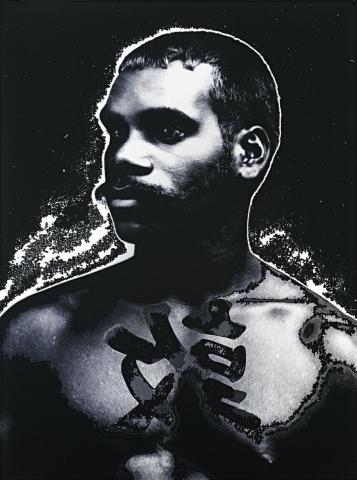SEXY AND DANGEROUS II, 1997
BROOK ANDREW
duclear print mounted on Perspex
144.5 x 108.0 cm
edition of 10
Gallery Gabrielle Pizzi, Melbourne
Private collection, Melbourne
Brook Andrew is a contemporary artist whose conceptual approach to his art production focuses on how we view images. In both his use of mediums, print, neon and photo-media and in his investigation of power relationships, particularly global ideas of cultural and race constructions, he quietly confronts the viewer. His often seemingly benign work will house an underlying assault on conventional values. Ashley Crawford has observed that Brook Andrews' photography 'is imbued with a gentle poetry and a savage anger at the same time, a strange balance that he describes as extremely powerful... a finely honed aesthetic sense, humour and tough political social commentary are Andrews signature.'1
Andrews came to prominence early, holding his first exhibition at Artspace in Sydney at the age of 23. In 2004 Andrew won the Works on Paper section of the National Aboriginal and Torres Straits Islander Art Award and a survey exhibition Eye to Eye was held at the Monash University Gallery, Melbourne, in 2007.
Sexy and Dangerous II, 1997, is the twin of Andrews' most well known work Sexy and Dangerous, 1996, first exhibited in 1998 at the Ian Potter Museum University of Melbourne, where it was awarded the RAKA prize. In 1999 the National Gallery of Victoria acquired a copy of Sexy and Dangerous for its permanent collection.
Both works subvert anthropological representations of Aboriginal men, re-contextualising them out of the museum diorama and into a space which is both sexy and dangerous, political and poetic. The work highlights one of the central tenants of Andrews' practice, described by him as being 'the joy and the mystery of art. That we can somehow work out a strategy of conveying the world or parts of it. In many cases, art has been a moveable social justice system; a system that condenses and clarifies questions about morality, nationhood, personal expression, beliefs, etc 'So maybe it is a loop - a loop where artists address and imagine other possibilities.'2
1. Loxley, A., The Battles continue: Brook Andrew in Ryan, J., (ed) Colour Power; Aboriginal Art Post 1984, in the collection of the National Gallery of Victoria, National Gallery of Victoria, Australia, 2004, p. 142
2. from a conversation between Brook Andrew and Maria Hlavajova, The Imagined Place Down Under, in Brook Andrew: Theme Park, Museum of Contemporary Aboriginal Art, The Netherlands, 2008, p. 22
